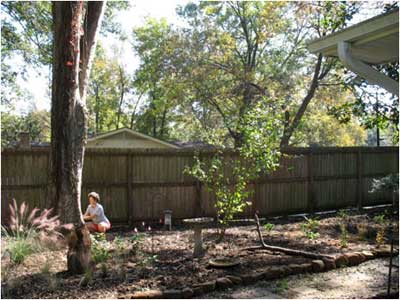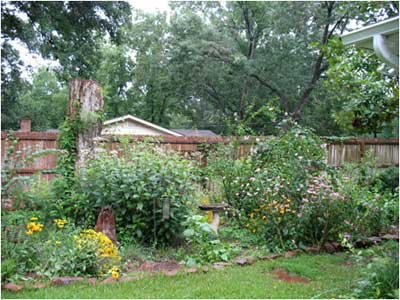Save Your Yard
Trying to keep St. Augustine grass and other non-native “water hogs” alive during the drought can be expensive and frustrating.
But in every challenge there is opportunity. As weather conditions improve, it’s a good time to think about replacing drought-stricken yards with native “Wildscapes” that are better suited for surviving Texas weather. They’re colorful, require little water or care, and attract birds, butterflies and other native wildlife.
Get guidance on what trees, flowers and shrubs work best for your region. Fall is usually the best time to plant but be sure to consult with your local nursery on what makes sense to plant during a drought.

Lawn before wildscape (November 2008)

Lawn after wildscape (June 2010)
Make the Transition to Native
- Now is a good time to begin minimizing your yard’s resource-needy plants (such as St. Augustine grass) to make room for heartier native plants. Worried about being cited for dead grass? Home Owner Associations are not allowed to enforce any green-lawn ordinances that contradict local water authority watering restrictions.
- To keep the ground occupied until conditions are right for planting, try planting annual ryegrass or lay down 2-3 inches of shredded native mulch (cedar works really well for this) to prevent weed seeds from sprouting in the periodic rains. Not only will it help make your yard more scenic, but also prevent invasive plants from taking root.
- And speaking of invasive plants and weeds, now is the time to get rid of them as they’re likely already stressed and more vulnerable to removal.
- Consider planting on a very small scale. Choose plants from your wildscape plan that are perennials. If local ordinances allow, use a soaker system (water deeply but less frequently) to help them develop a deep, healthy root system. Remember that frequent watering leads to shallow roots, and shallow roots are less adapted to our weather extremes. Trees usually need more water to get established while shrubs can usually get by with less so consider planting some of the shrubby areas--foundation areas, anchor landscape plants, songbird retreats, etc.--in your plan now.
- The Lady Bird Johnson Wildflower Center has a Native Plant Information Network, including recommended plants per region.
Care for Your Trees
Worried about your trees dying? The Texas Forest Service has created a video on how to water trees. Be sure to observe local watering restrictions.
Firescape Your Yard to Minimize Fire Risk to Your Home
- Create a defensible space perimeter immediately around your home: plant low-growing, low flammability species that are well within the reach of your water hose. Keep this area well watered.
- Thin trees and brush within the defensible space perimeter and remove "ladder fuels" (vegetation, like vines or shrubs), that would carry fire from the ground up into the trees or roof of a house.
- Remove dead plants, excess leaves, dead wood and low-hanging branches.
- Replace dense, flammable vegetation with more fire-resistant plants. Check with your local nursery or get some firewise recommedations from the U.S. Fish & Wildlife Service.
- You can still plant your wildlife habitat plantings in groupings in a zone slightly away from the house if you follow the guideline: "right plant in the right place."
- Store firewood away from the house.
Get Maximum Benefit from Watering Your Yard
It's especially important to maximize your yard-watering benefits when dealing with water restrictions. The Texas Water Development Board provides the following tips.
- Prevent evaporation of water. Water lawns early in the morning or in the evening during the hotter summer months. Never water on windy days.
- Use watering methods that reduce spraying toward the air. Spray toward the ground instead.
- One inch of water per week in the summer will keep most Texas grasses healthy. To determine how long you should run your sprinklers, place straight-edged cans at different distances away from the sprinkler and time how long it takes to fill an average of 1 inch of water in each can.
- Don’t abuse the benefits of an automatic sprinkler system by over-watering. Set it to provide thorough but infrequent watering. Check sprinkler heads regularly to make sure they are working properly. Install rain shut-off devices and adjust sprinklers to eliminate coverage on pavement.
- Use drip irrigation systems for bedded plants, trees, or shrubs and use low-angle sprinklers for lawns. Cover pools and spas. This can save the equivalent of your pool volume each year!
- Harvest the rain. Buy a rain barrel or a cistern and collect the water from your gutters to water your plants.
- Use your water efficiently. Don’t waste water by cleaning patios or sidewalks with it; use a broom. For plants that need more water, use a hose or watering can to give them additional water.
- Don’t scalp lawns when mowing during hot weather. Taller grass holds moisture better. Leave lawn clippings on the lawn instead of bagging.
- Use lots of mulch around your shrubs and trees. It will retain moisture, reduce run-off, moderate soil temperatures, and help with weed control.
- Don’t over-fertilize! Get a soil kit to determine what nutrients your soil needs. If you apply fertilizer only in the spring and fall, your grass will be healthy, use less water, and require less mowing.
- Use a car wash that recycles water. If you are washing your car at home, use a bucket of soapy water and a hose nozzle that shuts off the water while you scrub.
In partnership with the following water conservation programs:





